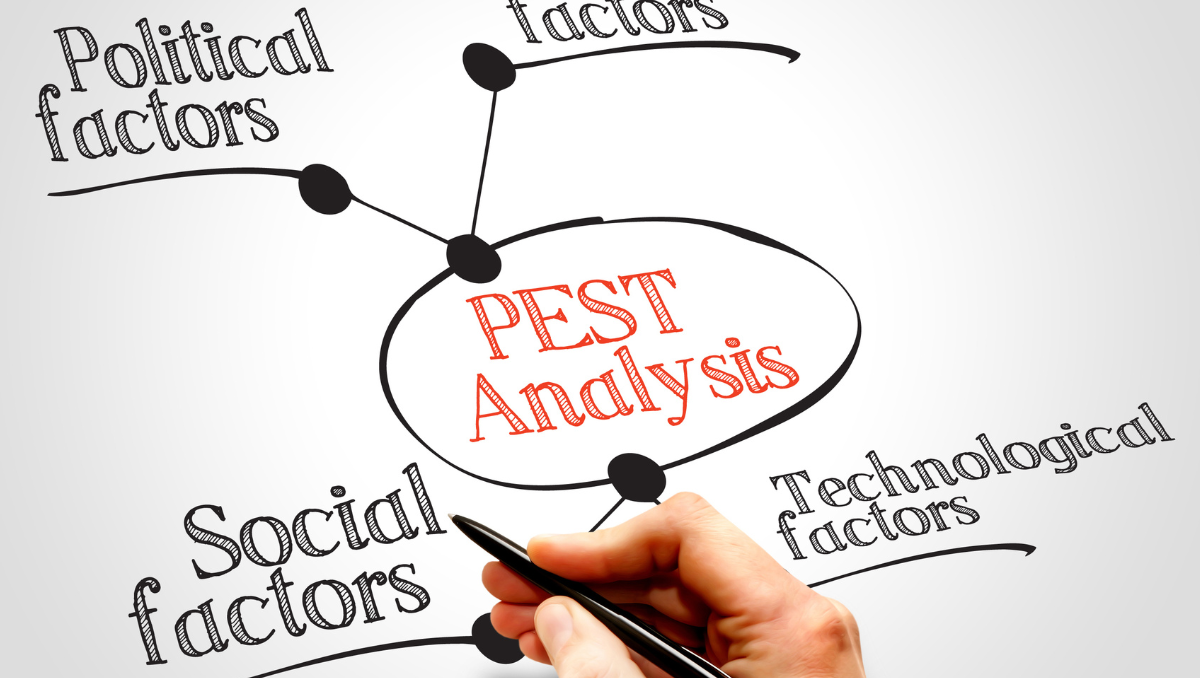In our interconnected world the localization industry plays an indispensable role, acting as the bridge between global brands and local markets. By adapting products, services, and content to specific cultural, linguistic, and regional nuances, localization ensures that businesses can genuinely resonate with diverse audiences across the globe. This industry doesn’t operate in a vacuum. It continually faces challenges, from cultural intricacies to technological advancements, all of which influence its trajectory.
PEST analysis is a strategic tool that has been a cornerstone in business planning for decades. By examining the Political, Economic, Social, and Technological factors, PEST analysis provides companies with a comprehensive view of the external macro-environment which directly or indirectly impacts their firm. The analysis encourages businesses to be proactive, rather than reactive, to the ever-changing external forces that can impact on operations and strategies. For the localization industry, understanding PEST factors is pivotal, offering insights into current challenges and future opportunities in a dynamic global marketplace.
Employing PEST analysis at a localization company serves a dual purpose. Firstly, it allows these companies to scan and evaluate the broader environment they operate within, ensuring they remain agile and informed in the face of potential external shifts. This proactive approach can lead to better decision-making and strategic alignment. Secondly, when communicating with customers or potential clients, PEST analysis can be a powerful tool to highlight the value of language and cultural adaptation in their operations. By showcasing how various external factors can influence consumer behaviour, preferences, and market trends, localization companies can highlight the strategic importance of their services. PEST analysis is a framework which is often used in my localization workshops.
Preparing for PEST Analysis
It’s essential to establish clear objectives. The goal might be to identify new market opportunities or anticipate challenges, having a defined purpose ensures that the analysis remains focused and relevant.
Choosing the right participants is the next crucial step. A successful PEST analysis will thrive on diverse insights. It’s beneficial to assemble a team of managers from various departments, be it marketing, finance, operations, R&D or wherever. Their collective expertise will ensure a holistic view of the external environment. Additionally, having a skilled facilitator can be invaluable. This individual can guide the discussion, ensuring it remains on track and that all perspectives are considered.
For the analysis to be grounded in reality, managers should be equipped with up-to-date articles, market reports, and data pertinent to the PEST factors. While distributing these materials in advance is a proactive approach, it’s also crucial to recognise that due to their busy schedules or other commitments, some managers might not thoroughly go through the pre-reading. As such, it’s beneficial to allocate some time at the beginning of the session to briefly review the key points of the provided materials. This ensures that all participants, regardless of their level of preparation, have a baseline understanding and any questions can be fielded early on.
The logistics and setting play a subtle yet significant role. You could be working physically or connecting online, but creating a distraction-free environment is important to foster concentration and engagement. For online sessions, choose a reliable virtual meeting platform, ensure that all participants have stable internet connections and are familiar with the platform’s features (a test session might be beneficial beforehand). Also ensure that all necessary materials, whether digital or physical, are readily accessible to participants and localised into their language.
Conducting the Analysis
The actual analysis begins with a brainstorming session. It’s essential to create an environment where managers feel free to express their thoughts and insights. Encourage an open discussion where participants delve into their observations on each of the PEST factors. Whether you’re in a physical room using a whiteboard or in a virtual setting, utilising digital collaboration tools can be invaluable. These tools can help in documenting ideas, ensuring that no insight gets overlooked.
Following the brainstorming, the session should transition into a more structured discussion. Dive deeper into each PEST factor, exploring its current status, potential changes on the horizon, and what these might mean for the organisation. It’s crucial for managers to substantiate their points, drawing upon data, market reports, or real-world examples. This evidence-based approach ensures that the analysis is both rigorous and relevant.
While all the factors discussed are important, they won’t all carry the same weight concerning their impact on the organisation. It’s a good idea to rank and prioritise them. Evaluating each factor based on its potential influence on the organisation, you can determine where to focus resources and attention, and that the most critical areas are addressed first.
To assist the reader I have created a small group of questions under each topic. Please use these only as a starting point as the specifics for your own Localization company will be specific to your own customers and markets.
Example Political Questions
- How do government policies around language and communication affect our services?
- Are there regulations concerning the translation or interpretation of official documents?
- What are the political stances on multilingual education and communication in our key markets?
- How might changes in immigration policies influence the demand for language services?
- Are there any data protection laws affecting the storage and transfer of translated content?
- How do trade agreements between countries influence the demand for cross-language business communication?
Examples Economic Questions
- How do economic growth rates in multilingual countries impact the demand for our services?
- Are there currency exchange fluctuations affecting pricing for international projects?
- How do employment rates influence the availability of qualified linguists and translators?
- What’s the financial outlook for sectors heavily reliant on translation, like tourism and international business?
- How are global recessions or economic booms affecting the outsourcing of language services?
- Is there a growing demand for specific language pairs due to economic partnerships between countries?
Example Social Questions
- What are the prevailing language trends, and which languages are increasing in demand?
- How do migration patterns influence the need for specific language services?
- Are there societal shifts emphasising the importance of multilingual education and training?
- How do cultural nuances and idioms impact the quality and approach to translation?
- Is there an increasing demand for localization services due to global content consumption?
- How are social movements, like globalisation or nationalism, affecting the perception and importance of multilingual communication?
Example Technological Questions
- How are advancements in machine translation and AI impacting the LSP industry?
- Are there emerging platforms or software improving the efficiency and accuracy of translation?
- How do cybersecurity trends affect the protection of translated content and client data?
- Is there a growing demand for digital localization services due to the rise of e-commerce and digital platforms?
- How are cloud-based solutions influencing collaboration and project management within the localization industry?
- Are there innovations in voice recognition or real-time translation that can create new service offerings?
Post-Analysis Actions
Once the PEST analysis is concluded, the insights from it need to be transformed into tangible steps and strategies. This is done via the correct documentation. Every insight, discussion point, and conclusion from the session should be compiled into a comprehensive report. This serves a strategic purpose. It is used for future strategic planning, decision-making, and should be revisited whenever the organisation seeks clarity on external factors.
With the documentation in place, the focus should shift to action planning. The analysis would have (hopefully) highlighted areas that require attention, strategies that need tweaking, or entirely new paths to be explored. For each of these, specific actions or strategies must be outlined.
Clear responsibilities should be assigned to ensure accountability. Timelines should be set to provide a roadmap for execution. A structured approach ensures that insights from the analysis translate into real-world impact.
Important to note that the business landscape is constantly changing. As such, the PEST analysis should not be a one-off exercise. By revisiting and updating the analysis at regular intervals, localization companies ensure that their understanding of the macro-environment remains current, and their strategies remain aligned with the changing realities.
Communicating the Findings
After conducting the PEST analysis and outlining the subsequent actions, the findings need to be communicated to the relevant stakeholders. This transparency keeps everyone informed and enhances alignment across departments and hierarchies. When every individual understands the external factors influencing the organisation and the strategies in place to navigate them, it ensures a unified approach in execution.
Engaging with external stakeholders is equally critical. Partners, investors, and even key customers have a vested interest in the strategic direction of the company. By sharing relevant insights from the PEST analysis with them, you not only keep them informed but also reinforce their confidence in the organisation’s strategic acumen. Such proactive communication can strengthen relationships, build trust, and pave the way for collaborative opportunities in the future.











Leave a Reply